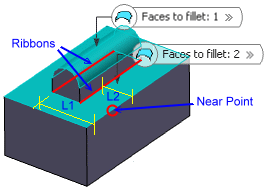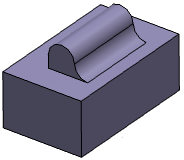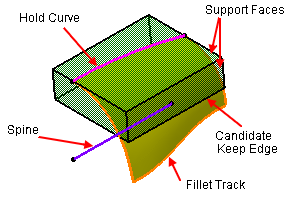More About Face-Face Fillet | ||||
|
| |||
Face-Face Fillet Definition Dialog Box
In Face-Face Fillet Definition dialog box, you can define a face-face fillet using various options:
Conic Parameter
The Conic Parameter option allows you to vary the section of the fillet. For a parameter comprised between or equal to:
- 0.5, the resulting curve is a parabola.
- 0 < parameter < 0.5, the resulting curve is an arc of an ellipse.
- 0.5 < parameter < 1, the resulting curve is a hyperbola.
If the conic mode is activated, the Edge(s) to keep, the Hold Curve and Spine options cannot be selected (and vice-versa).
Conical fillets do not handle twist configurations. If a twist is detected, the fillet operation fails.
If the fillet surface curvature is lower than the support curvature, fillet surface trimming may fail. In such cases, you need to decrease the conic parameter.
Near Point
The Near Point option allows you to select faces as per your requirement to form face-face fillet. If the selected faces to fillet form multiple ribbons, you can specify a reference point nearest to the required ribbon in the Near Point box.
In the below example, two ribbons are formed from the selected faces:
In this case, you can specify a reference point in the Near Point box. The ribbon nearest to this reference point is selected. The result is as shown below:
The following contextual commands for creating the reference point are available from the Near Point box:
- Insert Wireframe > Create Point: For more information, see Generative Shape Design User's Guide: Creating Wireframe Geometry: Creating Points.
- Insert Wireframe > Create Midpoint: Creates the midpoint of the line you select.
- Insert Wireframe > Create Endpoint: Creates the endpoint of the line you select.
- Insert Wireframe > Create Intersection: For more information, see Generative Shape Design User's Guide: Creating Wireframe Geometry: Creating Intersections.
- Insert Wireframe > Create Projection: For more information, see Generative Shape Design User's Guide: Creating Wireframe Geometry: Creating Projections.
- Insert Operations > Create Extract: For more information, see Generative Shape Design User's Guide: Performing Operations on Shape Geometry: Extracting Geometry: Extracting Elements.
Edges to keep
You can specify the edges of support body to be kept and create fillet surfaces with hold curve and keep edge as support wherever necessary. This helps in two different situations:
- Initializing the fillet ribbon when no portion of ribbon track
lies within the limits of the provided support face.

- Computing the fillet surfaces with keep edges as supports, whenever
the default fillet ribbon track crosses the edges to be kept.

The Edges to keep box is defined in the Face-Face Fillet Definition dialog box which is unavailable by default. If a hold curve is selected, the Edges to keep box becomes available. As soon as an edge to be kept is selected, it turns purple.
This option is available only if a Cast & Forged Part Optimizer license is used.
It is possible to perform thickness, shell, boolean operations on the resulting fillet surface.
It is possible to specify limiting element.
Keep edges of type "Round Corner" is not supported.
The Keep edges should be specified explicitly.
The fillet ribbon has zero radius at the points where the Keep edges intersects the hold curve. There can be maximum two such points in a fillet ribbon i.e. one at each end of the fillet ribbon.
Fillet operation may fail in the cases where the keep edge intersects the support face of hold curve.
Keep edges cannot be the border of edges.
Keep edges should be sharp.
Fillet operation fails if twists are encountered.
Limiting Element
Contextual commands creating the limiting elements you need are available from the Limiting element box:
- Insert Wireframe > Create Plane: For more information, see Generative Shape Design User's Guide: Creating Wireframe Geometry: Creating Planes.
- Insert Wireframe > XY Plane: The XY plane of the current coordinate system origin (0,0,0) becomes the limiting element.
- Insert Wireframe > YZ Plane: The YZ plane of the current coordinate system origin (0,0,0) becomes the limiting element.
- Insert Wireframe > ZX Plane: The ZX plane of the current coordinate system origin (0,0,0) becomes the limiting element.
- Insert Operations > Create Join: Joins surfaces or curves. See Generative Shape Design User's Guide: Performing Operations on Shape Geometry: Joining Surfaces or Curves.
- Insert Operations > Create Extrapol: Extrapolates surface boundaries or curves. See Generative Shape Design User's Guide: Performing Operations on Shape Geometry: Extrapolating Surfaces and Extrapolating Curves.
If you create any of these elements, the application then displays the corresponding icon in front of the Limiting element box. Clicking this icon enables you to edit the element.
Hold Curve
Instead of entering a radius value, you can use a "hold curve" to compute the fillet. Depending on the curve's shape, the fillet's radius value is then more or less variable.
Contextual commands creating the curves you need are available from the Hold Curve box:
- Insert Wireframe > Create Line: For more information, see Generative Shape Design User's Guide: Creating Wireframe Geometry: Creating Lines.
- Insert Wireframe > Create Intersection: For more information, see Generative Shape Design User's Guide: Creating Wireframe Geometry: Creating Intersections.
- Insert Wireframe > Create Projection: For more information, see Generative Shape Design User's Guide: Creating Wireframe Geometry: Creating Projections.
- Insert Operations > Create Join: Joins surfaces or curves. See Generative Shape Design User's Guide: Performing Operations on Shape Geometry: Joining Surfaces or Curves.
- Insert Operations > Create Boundary: For more information, see Generative Shape Design User's Guide: Performing Operations on Shape Geometry: Creating Boundaries.
- Insert Operations > Create Extract: For more information, see Generative Shape Design User's Guide: Performing Operations on Shape Geometry: Extracting Geometry: Extracting Elements.
If you create any of these elements, the application then displays the corresponding icon in front of the Hold Curve box. Clicking this icon enables you to edit the element.
The Generative Shape Design product license is required to access this capability.
Spine
The spine can be a wireframe or a sketcher element.
Contextual commands creating the spines you need are available from the Spine box:
- Insert Wireframe > Create Line: For more information, see Generative Shape Design User's Guide: Creating Wireframe Geometry: Creating Lines.
- Insert Wireframe > X Axis: The X axis of the current coordinate system origin (0,0,0) becomes the direction.
- Insert Wireframe > Y Axis: The Y axis of the current coordinate system origin (0,0,0) becomes the direction.
- Insert Wireframe > Z Axis: The Z axis of the current coordinate system origin (0,0,0) becomes the direction.
- Insert Operations > Create Join: Joins surfaces or curves. See Generative Shape Design User's Guide: Performing Operations on Shape Geometry: Joining Surfaces or Curves.
- Insert Operations > Create Boundary: For more information, see Generative Shape Design User's Guide: Performing Operations on Shape Geometry: Creating Boundaries.
- Insert Operations > Create Extract: For more information, see Generative Shape Design User's Guide: Performing Operations on Shape Geometry: Extracting Geometry: Extracting Elements.
If you create any of these elements, the application then displays the corresponding icon in front of the Spine box. Clicking this icon enables you to edit the element.